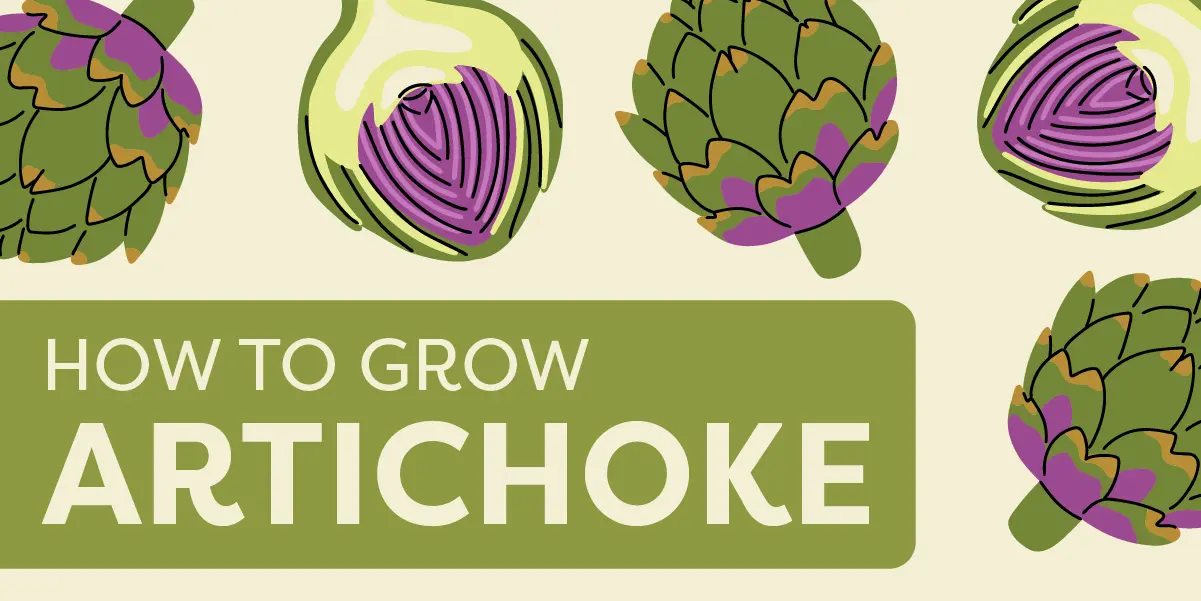Artichokes are cool-season perennials. In California, they’re typically planted in the fall and produce buds in the spring after they overwinter.
They require cool weather to form buds, a chilling period known as vernalization. The plants thrive in mild winters between 50 and 60 degrees F and cool, moist summers between 70 and 80 degrees F, making them an ideal California coastal crop.
Nevertheless, they’ll grow inland, albeit with a little extra care. The Green Globe variety grows in California’s coastal regions, while the Imperial Star variety is better suited for inland valleys. A popular heirloom variety with purplish leaves is the Violetto Artichoke, which can thrive in coastal and inland climates alike.
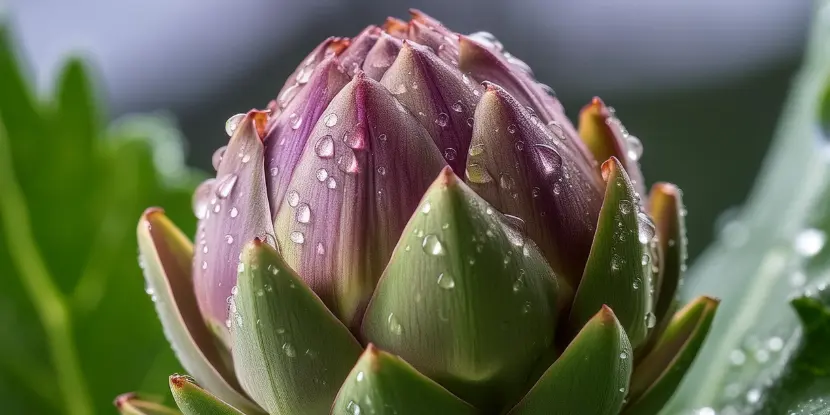
The purplish bud of an heirloom artichoke.
The Origin of Artichokes
Artichokes are thistles. Known scientifically as Cynara scolymus, they come from the Mediterranean region, particularly from countries like Italy and Spain.
While most thistles are treated as weeds, the artichoke stands out for its delicious flavor and striking appearance. The plant features large, bold leaves and vibrant purple flowers, adding beauty to landscapes and earthy, nutty tones to various dishes.
Why Artichokes Flourish in Coastal California
- Coastal California’s mild temperatures (rarely too hot or cold) are ideal for artichoke growth. The plants need a frost-free environment with a consistent temperature range to thrive.
- Well-draining, loamy soil enriched with organic matter supports healthy artichoke plants. Coastal soil often has these characteristics.
- Moderate humidity levels along the coast help prevent pests and diseases that can plague artichokes in other regions.
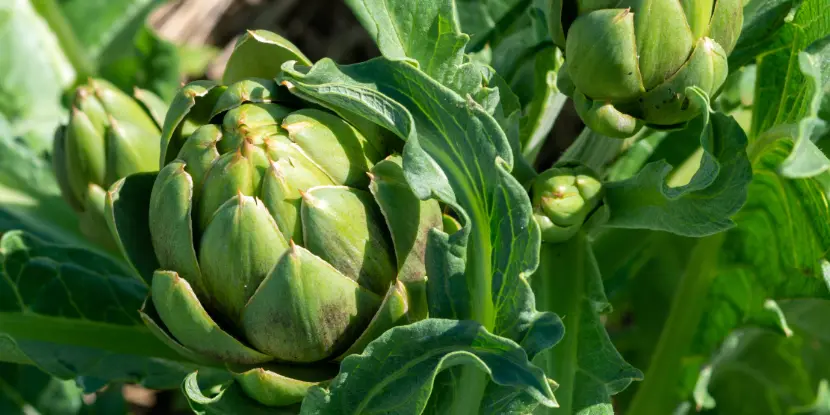
New artichoke buds forming on the plant.
Growing Artichokes
Artichoke seedlings may have to be artificially exposed to temperatures below 50 degrees Fahrenheit in early spring to encourage flower development in areas lacking naturally cool conditions.
The plants prefer full sun, although in hotter inland areas, they’ll benefit from afternoon shade. Choose a location with well-draining, fertile soil and plenty of space for the plants to spread, as they can grow up to 6 feet tall and 4 feet wide.
Soil Preparation
- Select a site with full sun exposure and protection from strong winds. Allow ample space for the artichokes to grow.
- Check the pH level with a soil testing kit. It should be slightly acidic to neutral, ideally between 6.0 and 7.0.
- Remove weeds, rocks, or debris from the planting area.
- If the pH is too low (acidic), add lime to raise it. Lower the pH with sulfur if it’s too high (alkaline).
- Incorporate organic matter, such as compost or well-rotted manure, to improve soil fertility and drainage.
- Till the soil to a depth of 12 to 18 inches, ensuring a well-aerated and loose environment for the roots.
- Rake the soil surface to create a smooth, level area, which aids in water distribution and prevents pooling.
Planting Seeds or Transplants
You can start artichokes from seeds, but using transplants gives a head start.
- Seeds: Start seeds indoors 8–10 weeks before the last frost date. Transplant them outside when they’re about 6 inches tall.
- Transplants: Space transplants 4–6 feet apart to allow room for growth.
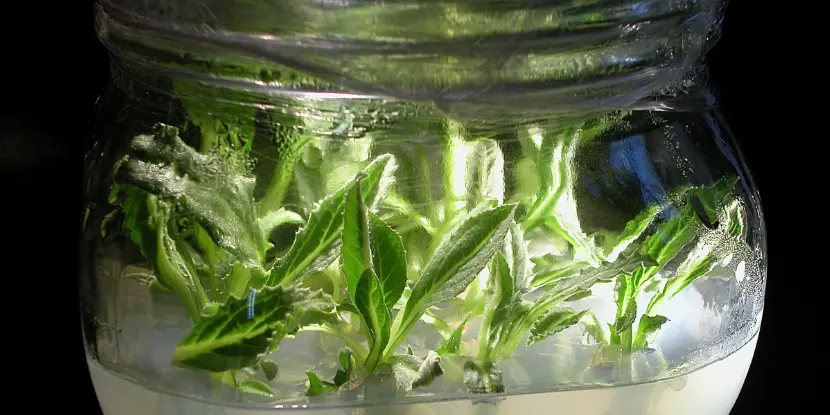
Young artichoke plants in a growing solution.
Mulching & Watering
- Apply a thick layer of mulch around the plants to conserve moisture and suppress weeds.
- Water the plants deeply and consistently, especially during dry periods.
- Artichokes prefer moist soil but dislike standing water.
Fertilizing
- In early spring, before new growth, apply a slow-release fertilizer to boost the plants after winter dormancy.
- Apply compost tea or a balanced organic fertilizer every 4-6 weeks.
- During the bud formation stage, consider using a fertilizer higher in potassium and phosphorus to promote bud development and quality.
- Avoid over-fertilizing, which encourages excessive foliage growth at the expense of bud production.
Pruning & Maintenance
- Regularly trim away dead or yellowing leaves.
- Every 3–4 years, divide crowns in early spring to rejuvenate plants and increase your artichoke population.
- After harvest, cut back the spent artichoke plants to about 1 foot tall to encourage new growth in the following season.
- Use a gentle hand when handling plants to avoid damaging the delicate stems and leaves.
- If the plant becomes too large or begins to crowd nearby plants, consider thinning to improve air circulation and light exposure.
- Cover young plants during unexpected late frosts to protect them from cold damage.
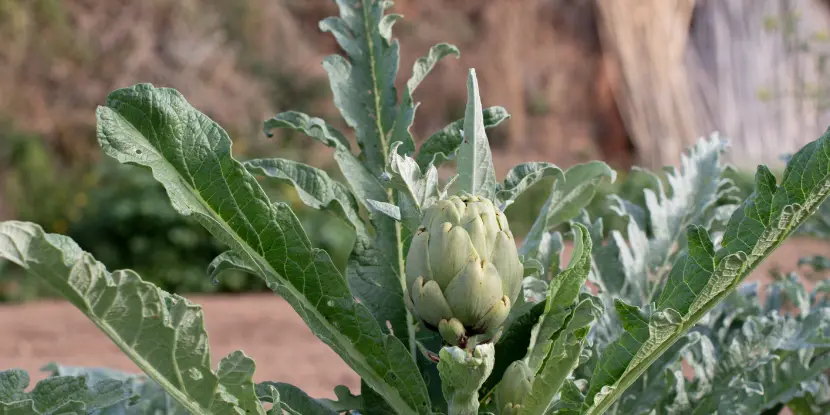
The artichoke is a thistle, a glorified weed.
Pests & Diseases
Pests
- Aphids: A strong stream of water can dislodge aphids from plants. For more severe infestations, use organic insecticidal soap.
- Slugs and Snails: Handpick them off your plants. Place beer traps or organic slug bait around your plants.
Management practices like introducing natural predators or barriers can help protect your plants.
Fungal Diseases
- Plant artichokes with enough space between them to allow air to circulate.
- Apply copper-based fungicides if you notice signs of mildew or other fungal issues.
Propagating Artichokes
Division Method
- Select healthy, mature artichoke plants at least 3 years old.
- Perform the division in early spring when the plants emerge from dormancy.
- Carefully dig around the base of the plant, lifting it gently from the ground without damaging the roots.
- Identify the crowns or base of the plant with multiple stems. Use the knife to cut through the crowns, ensuring each division has roots and at least one stem.
- Immediately transplant the divisions into prepared soil, spacing them 4–6 feet apart.
- Water the newly planted divisions well.
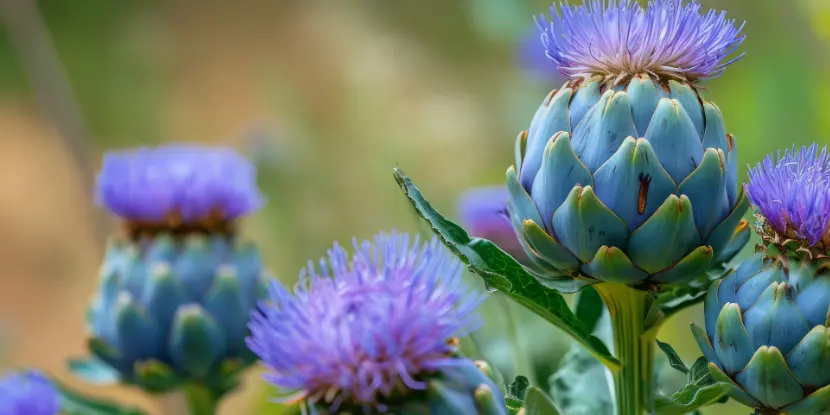
Artichoke blooms late in the growing season.
Offsets Method
- Look for small offsets (baby plants) emerging around the base of a mature artichoke plant.
- Carefully dig around the offset to expose the roots, then gently twist or cut them away from the main plant.
- Allow the cut ends to dry out for a few hours to reduce the risk of rot.
- Plant the offsets in a well-draining soil mix, ensuring they are at the same depth they were growing.
- Keep the soil consistently moist as the offsets establish their root systems.
Harvesting Artichokes
- Artichokes are ready to harvest when the buds are still tight and firm. If the buds start to open, they become tough and less palatable.
- Use a sharp knife or garden shears to cut the artichoke bud and a couple of inches of stem.
- Harvesting in the morning when temperatures are cool can help maintain freshness.
Storing Artichokes
- Fresh artichokes can be stored in the refrigerator for up to a week. They should be unwashed and wrapped loosely in plastic or a damp cloth.
- To freeze artichoke hearts, boil them for about 7 minutes, then plunge into ice water. Drain and pack into freezer bags or containers.
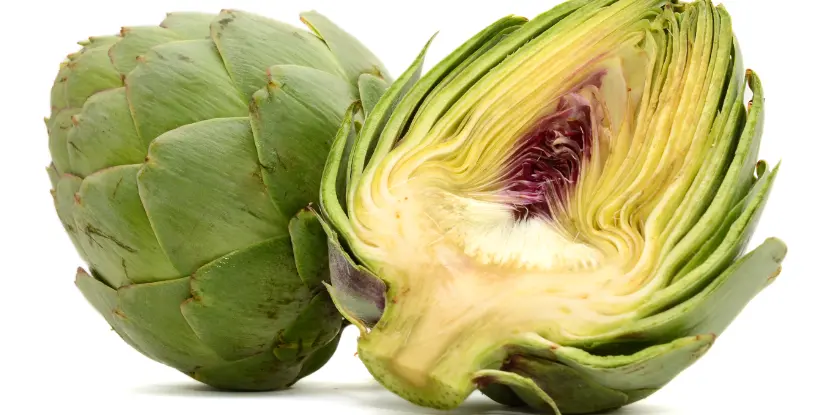
The tender heart of an artichoke bud.
FAQs: Growing Artichokes
Q: How long do artichoke plants live?
With proper care, artichoke plants can live up to 5 years. After the first year, they often produce greater yields.
Q: Can artichokes be grown in containers?
Yes, in large containers with adequate drainage. Ensure the container is at least 24 inches in diameter and depth.
Q: What’s the best time to harvest artichokes?
Harvest when the buds are tight and firm, typically in late spring to early summer. Cut the stem about 1–2 inches below the bud.
Q: How can I propagate artichokes?
Artichokes can be propagated from offshoots or “pups” that grow from the base of mature plants. Separate and replant these pups in late summer or early fall.
Q: Do artichokes require full sun?
Artichokes appreciate at least 6–8 hours of sunlight daily for optimal growth and healthy bud development.
Q: What type of soil is best for growing artichokes?
Artichokes prefer well-draining, loamy soil enriched with organic matter.
Q: How far apart should I plant artichokes in a row?
Space them 4–6 feet apart to allow for their large size and ensure good air circulation.
Q: Can I grow artichokes from store-bought artichokes?
Store-bought artichokes may not have viable seeds. Propagate them from established plants or nursery sources.

